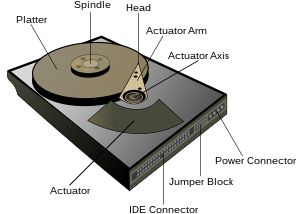HDDs record data by magnetizing ferromagnetic material directionally, to represent either a 0 or a 1 binary digit. They read the data back by detecting the magnetization of the material. A typical HDD design consists of a spindle that holds one or more flat circular disks called platters, onto which the data are recorded. The platters are made from a non-magnetic material, usually aluminum alloy or glass, and are coated with a thin layer of magnetic material, typically 10–20 nm in thickness — for reference, standard copy paper is 0.07–0.18 millimetres (70,000–180,000 nm) thick[8] — with an outer layer of carbon for protection. Older disks used iron(III) oxide as the magnetic material, but current disks use a cobalt-based alloy. [9]
The platters are spun at very high speeds. Information is written to a platter as it rotates past devices called read-and-write heads that operate very close (tens of nanometers in new drives) over the magnetic surface. The read-and-write head is used to detect and modify the magnetization of the material immediately under it. There is one head for each magnetic platter surface on the spindle, mounted on a common arm. An actuator arm (or access arm) moves the heads on an arc (roughly radially) across the platters as they spin, allowing each head to access almost the entire surface of the platter as it spins. The arm is moved using avoice coil actuator or in some older designs a stepper motor.
The magnetic surface of each platter is conceptually divided into many small sub-micrometre-sized magnetic regions, each of which is used to encode a single binary unit of information. Initially the regions were oriented horizontally, but beginning about 2005, the orientation was changed to perpendicular. Due to the polycrystalline nature of the magnetic material each of these magnetic regions is composed of a few hundred magnetic grains. Magnetic grains are typically 10 nm in size and each form a single magnetic domain. Each magnetic region in total forms a magnetic dipole which generates a highly localized magnetic field nearby. A write head magnetizes a region by generating a strong local magnetic field. Early HDDs used an electromagnet both to magnetize the region and to then read its magnetic field by using electromagnetic induction. Later versions of inductive heads included metal in Gap (MIG) heads and thin filmheads. As data density increased, read heads using magnetoresistance (MR) came into use; the electrical resistance of the head changed according to the strength of the magnetism from the platter. Later development made use of spintronics; in these heads, the magnetoresistive effect was much greater than in earlier types, and was dubbed "giant" magnetoresistance (GMR). In today's heads, the read and write elements are separate, but in close proximity, on the head portion of an actuator arm. The read element is typically magneto-resistive while the write element is typically thin-film inductive.[10]
HD heads are kept from contacting the platter surface by the air that is extremely close to the platter; that air moves at, or close to, the platter speed.[citation needed]The record and playback head are mounted on a block called a slider, and the surface next to the platter is shaped to keep it just barely out of contact. It's a type of air bearing.
In modern drives, the small size of the magnetic regions creates the danger that their magnetic state might be lost because of thermal effects. To counter this, the platters are coated with two parallel magnetic layers, separated by a 3-atom-thick layer of the non-magnetic element ruthenium, and the two layers are magnetized in opposite orientation, thus reinforcing each other.[11] Another technology used to overcome thermal effects to allow greater recording densities is perpendicular recording, first shipped in 2005,[12] and as of 2007 the technology was used in many HDDs.[13][14][15]
The grain boundaries turn out to be very important in HDD design. The grains are very small and close to each other, so the coupling between adjacent grains is very strong. When one grain is magnetized, the adjacent grains tend to be aligned parallel to it or demagnetized. Then both the stability of the data and signal-to-noise ratio will be sabotaged. A clear grain boundary can weaken the coupling of the grains and subsequently increase the signal-to-noise ratio. In longitudinal recording, the single-domain grains have uniaxial anisotropy with easy axes lying in the film plane. The consequence of this arrangement is that adjacent magnets repel each other. Therefore the magnetostatic energy is so large that it is difficult to increase areal density. Perpendicular recording media, on the other hand, has the easy axis of the grains oriented perpendicular to the disk plane. Adjacent magnets attract to each other and magnetostatic energy are much lower. So, much higher areal density can be achieved in perpendicular recording. Another unique feature in perpendicular recording is that a soft magnetic underlayer are incorporated into the recording disk. This underlayer is used to conduct writing magnetic flux so that the writing is more efficient. This will be discussed in writing process. Therefore, a higher anisotropy medium film, such as L10-FePt and rare-earth magnets, can be used.



No comments:
Post a Comment